 NIGHTBREED
(1990) Blu-ray/DVD combo
NIGHTBREED
(1990) Blu-ray/DVD comboDirector: Clive Barker
Scream Factory/Shout! Factory
 NIGHTBREED
(1990) Blu-ray/DVD combo
NIGHTBREED
(1990) Blu-ray/DVD comboClive Barker's uneven follow-up to HELLRAISER finally gets the director's cut treatment with a Scream Factory's release of the arduous restoration/director's recut of NIGHTBREED on Blu-ray/DVD combo special edition.
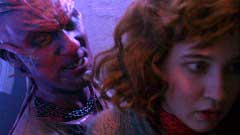
Calgary mechanic Aaron Boone (Craig Sheffer, SOME KIND OF WONDERFUL) has been troubled by nightmares of brutal murder as well as disturbing but increasingly more comforting dreams about a mythical land called Midian populated by monsters where he believes he can be free of his imaginary sins. His psychiatrist Decker (filmmaker David Cronenberg, SHIVERS) reveals to him that his nightmares might not be his imagination when he shows him photographs from the crime scenes of ten murders of family in the last six months. Decker gives him twenty-four hours to turn himself in to the police. He also gives him lithium pills to calm him, but they turn out to be a powerful hallucinogen and Boone winds up in the hospital on a bad trip where he meets vagrant actor Narcisse (Hugh Ross, KILLER'S MOON) who proves how eager he is to get into Midian by scalping himself. In the ensuing chaos at the hospital, Boone manages to escape just as Decker has brought the police – lead by Inspector Joyce (Hugh Quarshie, THE CHURCH) – who he has convinced that Boone is a highly manipulative and dangerous killer. Boone follows Narcisse's directions to Midian, which he discovers is a gold rush cemetery outside of the town of Shere Neck. As the sun sets, he discovers that Midian is indeed "where monsters go" and is bitten by shape shifter Peloquin (Oliver Parker, one of HELLRAISER's cheeky moving men). Boone manages to escape the cemetery only to be gunned down by the police who Decker has led to Midian. Decker believes he has covered his trail until Boone's body disappears from the morgue. Finding it hard to accept that her lover was a murderer, Boone's girlfriend Lori (Anne Bobby, THE PICK-UP ARTIST) drives up to Shere Neck searching for Midian, unaware that Decker has followed her and plans to use her to draw Boone out of hiding. Resurrected by Peloquin's bite, Boone returns to Midian and is initiated into the "Tribes of the Moon" by Midian's leader Lylesburg (Doug Bradley, HELLRAISER) making an oath to leave his natural life behind. Boone just as quickly breaks his oath to save Lori, revealing his undead status to Decker who then returns to town to stir up outcry with the locals – lead by fanatical police captain Eigerman (Charles Haid, ALTERED STATES) – against the residents of Midian who must break their own law against killing humans to fight back.
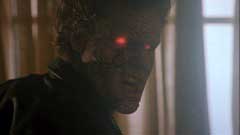 Based
on Clive Barker's own novel "Cabal", NIGHTBREED is a baroque exploration
of one of Barker's fantasy worlds (compared to the more suggestive HELLRAISER
and the minimalist world of the Cenobites explored in HELLBOUND: HELLRAISER
II). The murder mystery angle of the first act is a springboard to the supernatural,
with the identity of the real murderer very easily guessed as soon as he first
comes onscreen. The multi-tiered underworld of Midian is a literal freak show,
with many of the nightbreed playing to the roving camera representing the POV
of visitors like Boone and Lori. The emphasis on the film's core love story
and the sympathetic portrayal of the breed require a more caricatured portrayal
of the intolerant human characters (with only Quarshie as Inspector Joyce seeming
to take it upon himself to convey a flicker of sympathy or at least curiosity);
but that is very much in keeping with the theme of the film: that we as humans
fear monsters but dream about having the abilities of them (and what we envy,
we destroy).
Based
on Clive Barker's own novel "Cabal", NIGHTBREED is a baroque exploration
of one of Barker's fantasy worlds (compared to the more suggestive HELLRAISER
and the minimalist world of the Cenobites explored in HELLBOUND: HELLRAISER
II). The murder mystery angle of the first act is a springboard to the supernatural,
with the identity of the real murderer very easily guessed as soon as he first
comes onscreen. The multi-tiered underworld of Midian is a literal freak show,
with many of the nightbreed playing to the roving camera representing the POV
of visitors like Boone and Lori. The emphasis on the film's core love story
and the sympathetic portrayal of the breed require a more caricatured portrayal
of the intolerant human characters (with only Quarshie as Inspector Joyce seeming
to take it upon himself to convey a flicker of sympathy or at least curiosity);
but that is very much in keeping with the theme of the film: that we as humans
fear monsters but dream about having the abilities of them (and what we envy,
we destroy).
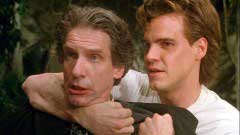
Although there are hundreds of other species of the breed – called to Midian by its builder/baptizer Baphomet – we only get to meet a core few, including porcupine woman Shuna Sassi (dancer Christine McCorkindale), shapeshifter Rachel (Catherine Chevalier, HELLBOUND: HELLRAISER II) and her feline daughter Babette, as well as literally crescent moon-faced Kinski and Lylesburg's fool Ohnaka (respectively HELLRAISER's "Chatterer" and "Butterball" Nicholas Vince and Simon Bamford). The late John Agar (TARANTULA) has a cameo as an unfortunate gas station owner. In terms of visual style, NIGHTBREED has aged well – particularly thanks to the cinematography of Robin Vidgeon (HELLRAISER) and the production design of Steve Hardie (LORD OF ILLUSIONS) – with only Sheffer's mullet and Bobby's music act screaming eighties. The creature make-up and lovely old school visual effects are the work of Image Animation – lead by Bob Keen (HELLRAISER) and Geoff Portass (LAIR OF THE WHITE WORM) but significantly expanded upon their original small crew – are more decorative than repellant (Narcisse's scalped head looks more rubbery than the wet, slimy, sensual look of the Cenobites' skinned victims), while Tony Gardner (DARKMAN) was responsible for the killer's slasher victims (stabs, slashes, severed heads, and all). Danny Elfman's score is richly orchestral and diverse, but it is offputtingly Tim Burton-esque compared to Christopher Young's score for HELLRAISER or Simon Boswell's for LORD OF ILLUSIONS.
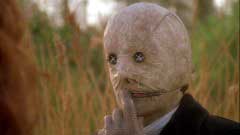
NIGHBREED was released theatrically by Twentieth Century Fox to indifferent reviews, gaining most of its cult audience on VHS, but the theatrical version was far from what Barker intended. Although producers Morgan Creek greenlighted the film as it was, they had apparently gone sour on the idea of that monsters could be good (although perhaps this was partly based on the reception of the earlier-released LITTLE MONSTERS in which Fred Savage explored the underworld where those monsters under the bed come from) and recut the film, ordering additional reshoots, and marketing it as a slasher ("Lori thought she knew everything about her boyfriend… Lori was wrong!"). Released on VHS by Media Home Entertainment (and laserdisc by Image Entertainment), NIGHTBREED made its digital debut on DVD in 2004 from Warner Home Video (Warner Bros. having taken over distribution of Morgan Creek productions in 1991) in a barebones anamorphic 1.78:1 widescreen transfer of the theatrical cut with the Dolby Digital 2.0 surround track and a 5.1 remix, the theatrical trailer, and text biographies (an Archive Collection burn-on-demand DVD-R followed in 2011). More recently, Mark Miller – vice president of Barker's Seraphim Film company – was given the go-ahead to track down all of the footage Barker shot for the film to restore his original cut. Morgan Creek proved unhelpful and a web campaign "Occupy Midian" was undertaken to convince them of commercial interest in the film. In the meantime, Miller was able to find workprint videotapes – some of which were among unmarked cassettes owned by Barker – and the director's friend Russell Cherrington assembled a composite from the VHS tapes and the Warner DVD.
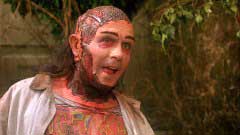
Known as "The Cabal Cut", this 144 minute version was a rough assembly of everything that had been recovered. This composite was screened worldwide with Morgan Creek's permission and appeared to be what would make it to DVD if it obtained a release until Miller and Scream Factory discovered the film materials in 2014. The director's cut – assembled from elements for the theatrical cut, the rediscovered film material, and audio from the workprint tapes – runs two hours and restores among other things Bradley's vocal performance (which was redubbed by another actor in Los Angeles), the fate of one character who died in the original cut but survived courtesy of reshoots for the theatrical cuts, Lori's musical performance early on, and the original ending (far superior to that dumb final shot in the theatrical version). Although the director's cut runs roughly twenty minutes longer than the theatrical cut (101:24), it actually contains over forty minutes of new footage as some footage from the theatrical cut has been substituted.
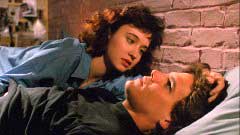 Scream
Factory's 1080p24 MPEG-4 AVC 1.78:1 transfer of the director's cut is of course
more detailed than the Warner transfer since it's in high definition and sourced
from the original camera negative (the Warner DVD and the theatrical cut on
the bonus third disc of Scream's limited edition are sourced from the American
inter-positive). It's also warmer with slightly less blue in the night shots
but bluer skies in the day scenes. Contrasts are superior and highlights do
not blow out as they had on the Warner disc. Framing varies slightly between
the two with slivers more side information sometimes visible in the new transfer
and sometimes less so, but not enough to unbalance the compositions (which would
have been matted to 1.85:1 in projection). Audio options include a DTS-HD Master
Audio 2.0 stereo rendition of the film's already active Dolby Stereo track (both
the vintage end credits crawl and the additional restoration credit sequence
feature Dolby Stereo rather than Dolby Digital logos), as well as a DTS-HD Master
Audio 5.1 track. Optional English SDH subtitles are also included.
Scream
Factory's 1080p24 MPEG-4 AVC 1.78:1 transfer of the director's cut is of course
more detailed than the Warner transfer since it's in high definition and sourced
from the original camera negative (the Warner DVD and the theatrical cut on
the bonus third disc of Scream's limited edition are sourced from the American
inter-positive). It's also warmer with slightly less blue in the night shots
but bluer skies in the day scenes. Contrasts are superior and highlights do
not blow out as they had on the Warner disc. Framing varies slightly between
the two with slivers more side information sometimes visible in the new transfer
and sometimes less so, but not enough to unbalance the compositions (which would
have been matted to 1.85:1 in projection). Audio options include a DTS-HD Master
Audio 2.0 stereo rendition of the film's already active Dolby Stereo track (both
the vintage end credits crawl and the additional restoration credit sequence
feature Dolby Stereo rather than Dolby Digital logos), as well as a DTS-HD Master
Audio 5.1 track. Optional English SDH subtitles are also included.
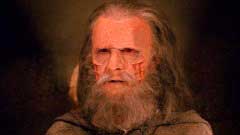
The feature presentation starts off with an introduction by Barker and restoration producer Mark Miller (5:30) in which they give a quick rundown of the restoration process. A husky-voiced Barker and Miller also appear in a brand new audio commentary, discussing the film itself as well as pointing out the differences in footage (including all of the setup that Morgan Creek wanted to get rid of to get to the murder scene) as well as the new enhancements (as well as sound elements from the workprint tapes). Barker recalls the trepidation he had in offering a role to Cronenberg because he was concerned as a still novice director that the other man would take over (Cronenberg was writing the script for his Burroughs film NAKED LUNCH during the shoot). In reassessing the film through the new transfer, Barker distinguishes the cold look of the regular settings and the warmer and more colorful world of Midian. Miller recalls reading "Cabal" and finding it a better story than the theatrical version, and making cold calls with those involved in it (Barker doesn't blame second editor Mark Goldblatt for cutting it in accordance with Morgan Creek's requirements and that the editor had worked hard to make sense out of the recut with little help from Barker who was in the editing room at the time). Details of the story of Morgan Creek's lack of faith in the production and what they did to it are woven throughout the other discussion (as well as the movement to restore the film and the efforts of Sheffer and Bobby for the cause).
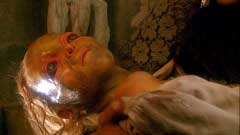 The
feature-length documentary "Tribes of the Moon" (72:17) collects the
separate recollections of actors Craig Sheffer, Anne Bobby, Doug Bradley, Simon
Bamford, Hugh Ross, and Christine McCorkindale. Bradley and Bamford start off
discussing their beginnings with Barker and his Dog Theatre company before being
offered HELLRAISER and its sequel. Sheffer and Bobby both recall reading the
book before the script and feeling comfortable working with other stage actors.
The cast also discuss their interpretation of their parts, with Bobby seeing
Greek hero qualities in her heroine's descent to save her lover, Ross' character
being an actor, Bamford seeing his character as fool to Lylesburg's King Lear,
and Bradley's Lylesburg as Moses trying to maintain the status quo of Midian.
They also discuss the trials of the make-up chair with Sheffer's Cabal facial
appliances taking six hours to apply and even longer for McCorkindale's porcupine
suit (she recalls that make-up application process was more trying than the
physicality of the role). Ross recalls being called back for three Sundays of
reshoots when Morgan Creek wanted to beef up his character's screen time, and
all of the participants recall sadly how different the theatrical cut was from
the script. The documentary also includes script pages, behind the scenes video,
alternate takes of scenes, gaffes, outtakes, and test footage (including McCorkindale
practicing her choreography without prosthetic make-up).
The
feature-length documentary "Tribes of the Moon" (72:17) collects the
separate recollections of actors Craig Sheffer, Anne Bobby, Doug Bradley, Simon
Bamford, Hugh Ross, and Christine McCorkindale. Bradley and Bamford start off
discussing their beginnings with Barker and his Dog Theatre company before being
offered HELLRAISER and its sequel. Sheffer and Bobby both recall reading the
book before the script and feeling comfortable working with other stage actors.
The cast also discuss their interpretation of their parts, with Bobby seeing
Greek hero qualities in her heroine's descent to save her lover, Ross' character
being an actor, Bamford seeing his character as fool to Lylesburg's King Lear,
and Bradley's Lylesburg as Moses trying to maintain the status quo of Midian.
They also discuss the trials of the make-up chair with Sheffer's Cabal facial
appliances taking six hours to apply and even longer for McCorkindale's porcupine
suit (she recalls that make-up application process was more trying than the
physicality of the role). Ross recalls being called back for three Sundays of
reshoots when Morgan Creek wanted to beef up his character's screen time, and
all of the participants recall sadly how different the theatrical cut was from
the script. The documentary also includes script pages, behind the scenes video,
alternate takes of scenes, gaffes, outtakes, and test footage (including McCorkindale
practicing her choreography without prosthetic make-up).
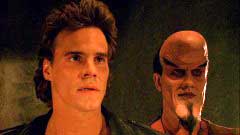
"Making Monsters" (42:11) interviews with makeup effects artists Bob Keen, Martin Mercer, and Paul Jones. Keen recalls the intention of Image Animation to be a workshop for creative development of effects rather than an assembly line, and that HELLRAISER was their first big break after HIGHLANDER. The three discuss how stimulating it was working with Barker, who was responsive to their questions and would sketch out his creatures in silhouette and in broad strokes, allowing for them to build upon the concepts themselves (Barker had social histories for the creatures which helped in choosing wardrobe and accessories for them as well). The great number of creatures and effects called for an expansion of the initial eight man crew, bringing in new people with fresh ideas and abilities. Unlike HELLRAISER and HELLBOUND where each of the crew worked on parts of appliances for each creature, NIGHTBREED required entire characters to be assigned to each of them. They also recall how they would sometimes have to double as creatures themselves when there were not enough extras, or when the extras had been released only for a certain creature to be needed on the set (Image Animation had a workshop on the Pinewood Studios lot). Jones also concedes that his make-up appliances were not up to snuff for the Ashberry (Malcolm Smith, MURDER BY PHONE), so he was relieved when they ended up reshooting the scene with him in Los Angeles (where Tony Gardener did the make-up). They also recall how much their skills had improved by the time of the reshoots, but all lament the final theatrical cut ("They fucked it up," says Keen). They also acknowledge the contributions of former crew members not interviewed here, including Geoff Portass and Mark Coulier (who recently won an Academy Award).
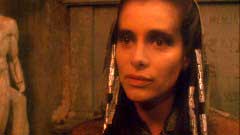 "Fire!
Fights! Stunts! 2nd Unit Shooting" (20:20) is an interview with second
unit director Andy Armstrong for which NIGHTBREED was his last production in
Britain since he directed the Calgary second unit footage before heading down
to Los Angeles to direct the additional unit footage there where he settled
and has been working since then. He discusses the process of dividing the action
scenes of the climax into shots that Barker was to direct and the ones with
extras that he would shoot, as well as matching British and Canadian Toyota
trucks to a remote control scale model for a miniature shot. He is complementary
of the talents of Barker, Image Animation, and cinematographer Robin Vidgeon
for bringing an epic feel to a genre that he feels is usually smaller scale.
Lastly, there is an original theatrical trailer (1:06) plays more like a teaser
offering little in the way of hints about the actual story and is framed for
some reason at 2.35:1 (presumably it was a trailer meant to precede Panavision
features). The disc cover features new art on the outside and the more attractive
original poster group shot on the reverse, as well as a cardboard slipcover
of the new art. The standard version is reviewed here, but Shout! has also released
a limited edition with a second Blu-ray disc of extras (including twenty minutes
of deleted and alternate scenes) as well as a third Blu-ray disc featuring a
high definition transfer of the theatrical cut. NIGHTBREED fans and Barker completists
will probably want to fork over the additional money for the limited edition,
but this standard edition offers a very satisfying presentation for the rest
of us. (Eric
Cotenas)
"Fire!
Fights! Stunts! 2nd Unit Shooting" (20:20) is an interview with second
unit director Andy Armstrong for which NIGHTBREED was his last production in
Britain since he directed the Calgary second unit footage before heading down
to Los Angeles to direct the additional unit footage there where he settled
and has been working since then. He discusses the process of dividing the action
scenes of the climax into shots that Barker was to direct and the ones with
extras that he would shoot, as well as matching British and Canadian Toyota
trucks to a remote control scale model for a miniature shot. He is complementary
of the talents of Barker, Image Animation, and cinematographer Robin Vidgeon
for bringing an epic feel to a genre that he feels is usually smaller scale.
Lastly, there is an original theatrical trailer (1:06) plays more like a teaser
offering little in the way of hints about the actual story and is framed for
some reason at 2.35:1 (presumably it was a trailer meant to precede Panavision
features). The disc cover features new art on the outside and the more attractive
original poster group shot on the reverse, as well as a cardboard slipcover
of the new art. The standard version is reviewed here, but Shout! has also released
a limited edition with a second Blu-ray disc of extras (including twenty minutes
of deleted and alternate scenes) as well as a third Blu-ray disc featuring a
high definition transfer of the theatrical cut. NIGHTBREED fans and Barker completists
will probably want to fork over the additional money for the limited edition,
but this standard edition offers a very satisfying presentation for the rest
of us. (Eric
Cotenas)